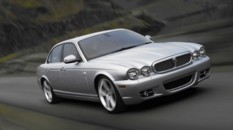Review
This week I’ve been driving a Jaguar XKR – a wonderful sportscar which embodies everything a Jaguar for the 21st century should be.
I mention this because last week I was driving an XJ – a dated saloon car which embodies everything that is wrong with Jaguar in the 21st century – a predominantly old-fashioned range struggling to compete with the German brands. As a result of this dearth of product, Jaguar has been put up for sale by parent company Ford.
The XJ has never looked modern. Even when it was launched back in 2003 it had a dated feel to it. Note I said dated, rather than retro, because some car firms have managed to successfully reinterpret their old models for today’s drivers (think MINI or Fiat with the 500). Jaguar is not one of them.
However, this traditional olde- worlde approach has managed to charm British buyers, and the XJ has been a popular seller in the luxury market. Sales were up by a quarter last year thanks to the introduction of a long wheelbase diesel model which has been embraced by the burgeoning chauffeur market.
But the fact remains that the XJ still sells in small numbers compared to the Audi A8, BMW 7 Series and Mercedes-Benz S-Class. However, things may be about to change if Jaguar is to be believed because what we now have is a “new-look” XJ for the 2008 model year.
Which is all well and good, except this new model looks pretty much the same as the last one with the exception of a new front grille and bumper unit, larger alloy wheels and a pair of metal gills in the front wings.
The metal gills work well and lend the car an air of muscularity, while the standard-fit 19-inch alloy wheels fill the arches well. Even the new grille looks good. But, and this is a big but, the new front bumpers are awful. They’re big and chunky, they do not sit with the curvaceous lines of the XJ. In my opinion, they look a bit aftermarket.
So despite this revamp the XJ still looks dated, but now it looks awkward as well. And this is a shame because under the metal lurks a very good car. With its all-aluminium construction, the XJ is light which aids economy, handling and ride quality. It excels at all three, providing a cosseting experience every time you get behind the wheel.
Then there’s the engine and gearbox – one of the smoothest and most refined combinations around. The twin-turbocharged 2.7-litre unit and six-speed automatic transmission provide seamless performance with virtually no noise or vibration intrusion into the cabin.
The XJ does luxury motoring very well. It’s just a shame that its old fashioned styling has deterred more people from experiencing it. With the clumsy restyle this doesn’t look like changing.
Fact file
P11D value: £44,787
CO2 emissions (g/km): 214
BIK % of P11D in 2007: 32%
Graduated VED rate: £205
Insurance group: 16
Combined mpg: 35.0
CAP RV (3yr/60k): £17,050/38%
Monthly lease (3yr/60k): £871
We like
Front-end price
Fuel economy
Refinement
Low running costs
We don’t like
Clumsy restyle
High SMR bills
THREE RIVALS TO CONSIDER
P11D price
The Jaguar looks keenly priced here, but there are a couple of items which are standard on the rest but optional on the XJ such as satellite navigation (£2,000) and metallic paint (£775). However, the Jaguar still undercuts the S-Class by a significant £10,000.
XJ: £44,787
A8: £49,407
730d: £51,177
S320: £54,767
Emissions and tax rates
With a near-£5,000 list price advantage over the rest, the XJ is naturally the cheapest on benefit-in-kind tax, costing a 40% taxpayer £477 a month. The BMW will cost the same taxpayer £563 a month, the Audi £576 and the S-Class £621 thanks to its high list price.
XJ: 214g/km/20%
< 730d: 216g/km/21%
S320: 220g/km/21%
A8: 227g/km/23%
SMR cost
The BMW leads the way with its £760 service pack which covers service and maintenance for five years/60,000 miles. The Jaguar has more expensive tyre bills – the XJ has 19-inch wheels while the Audi and Mercedes-Benz have 17-inch rims. The BMW offers 18-inch alloys.
730d: 5.83 (pence per mile) £3,498 (60,000 mile total)
A8: 5.84 £3,504
S320: 6.25 £3,750
XJ: 6.38 £3,828
Fuel cost
This is a very close contest, with just £390 in diesel separating first from last over 60,000 miles. Jaguar leads the way with combined fuel economy of 35.0mpg, with the BMW returning 34.4mpg. The S-Class is third with 34.0mpg and the quattro Audi last with 33.2.
XJ: 11.85 (pence per mile) £7,110
730d: 12.06 £7,236
S320: 12.20 £7,320
A8: 12.50 £7,500
Depreciation cost
With a massive list price advantage, the Jaguar is well ahead, and CAP predicts it will retain 38% of its cost new after three years/60,000 miles. The S320 leads the way on 41% but is much more expensive to buy at the front end. The A8 will retain 36% and the BMW 35%.
XJ: 45.89 (pence per mile) £27,534
A8: 51.22 £30,732
S320: 53.69 £32,214
730d: 55.33 £33,198
Wholelife cost
With such a large advantage in depreciation terms, the XJ was always going to come out on top in wholelife costs. At 64.12ppm it will cost a fleet just under £38,500 to run over three years/60,000 miles. The next closest challenger, the Audi A8, will cost £3,000 more.
XJ: 64.12 £38,472
A8: 69.56 £41,736
S320: 72.14 £43,284
730d: 73.22 £43,932
Verdict
At this rarefied level, cost is not the be-all-and-end-all and the choice will come down to your managing director’s personal preference. The XJ beats the others hands-down in running costs, but it is an old car now and looks it. The other three are far more contemporary but the S-Class stands above them with its blend of performance, technology, style and road presence. It’s expensive, but very much worth it.
















